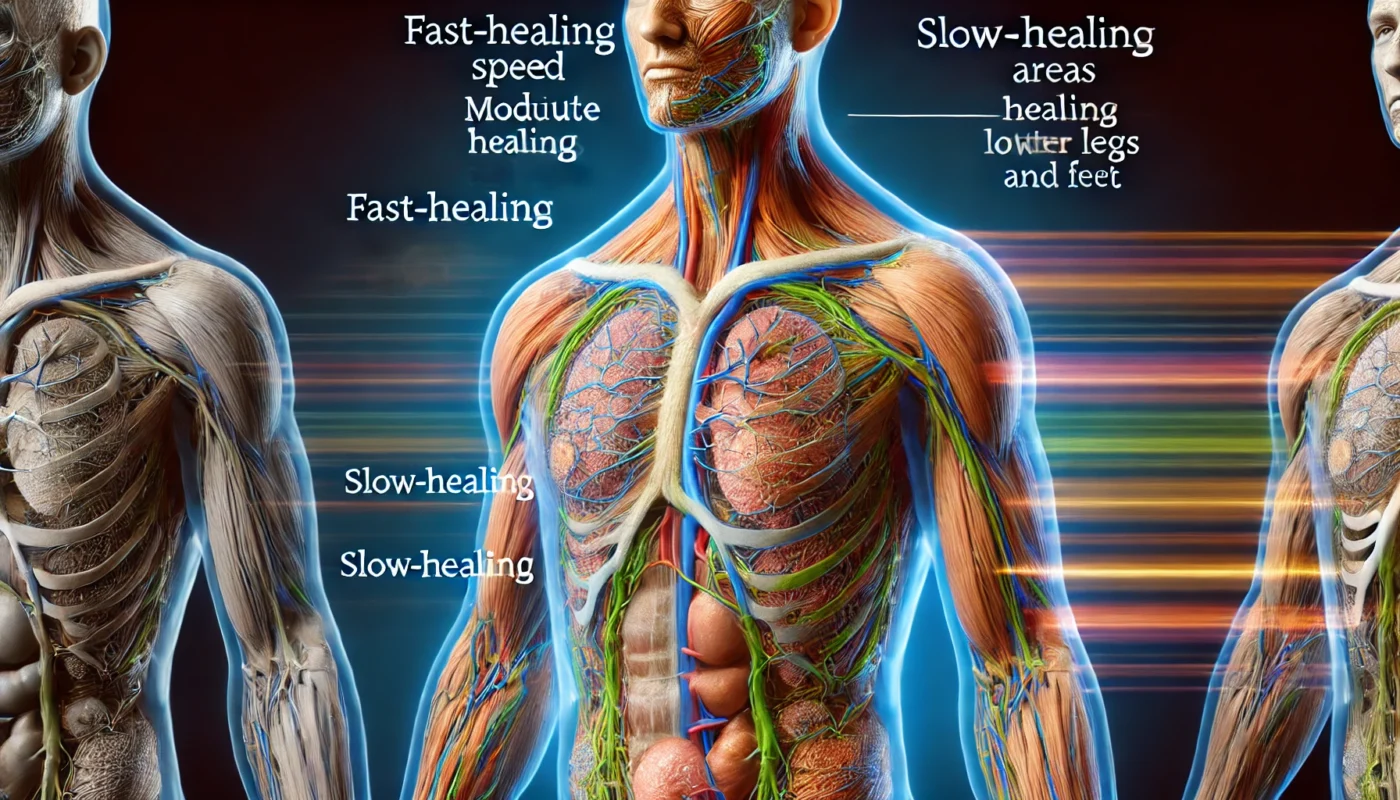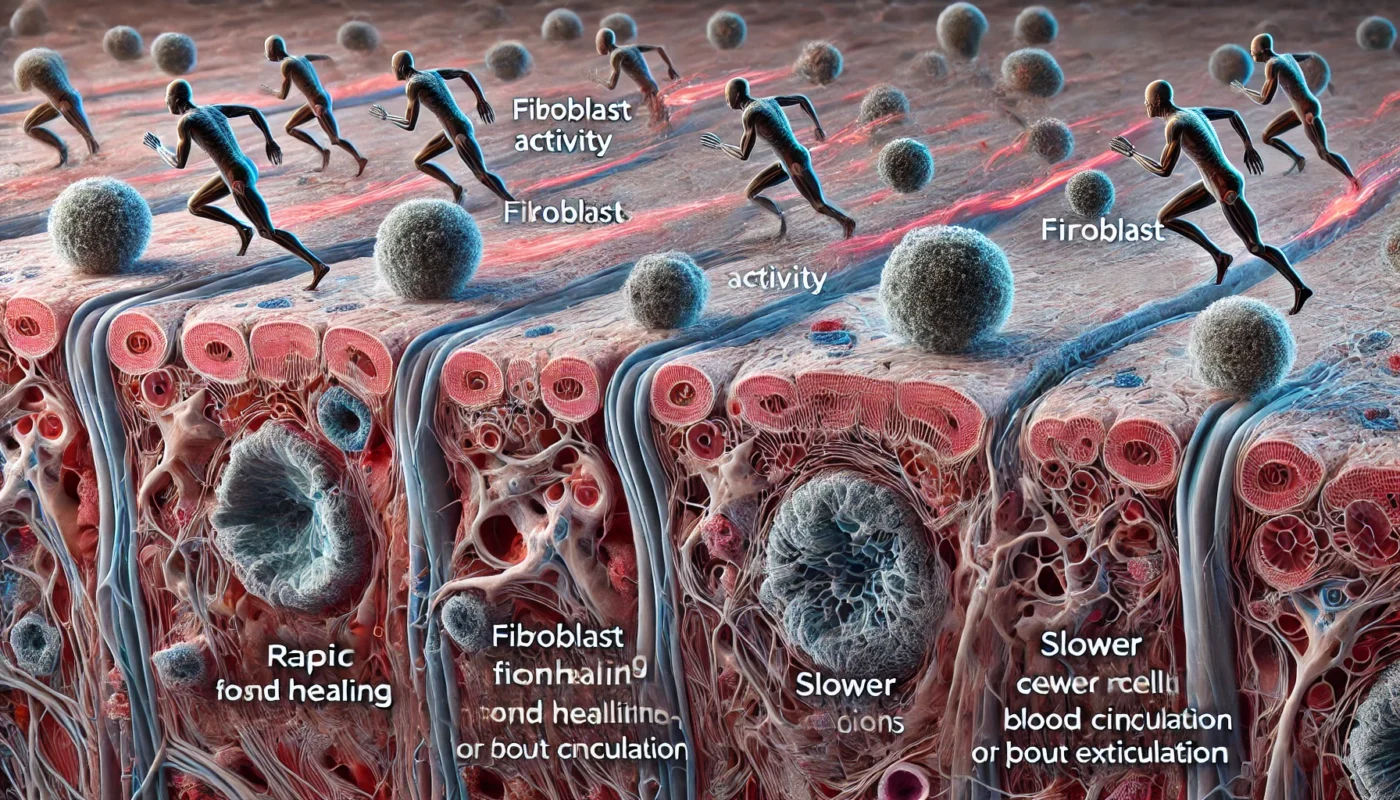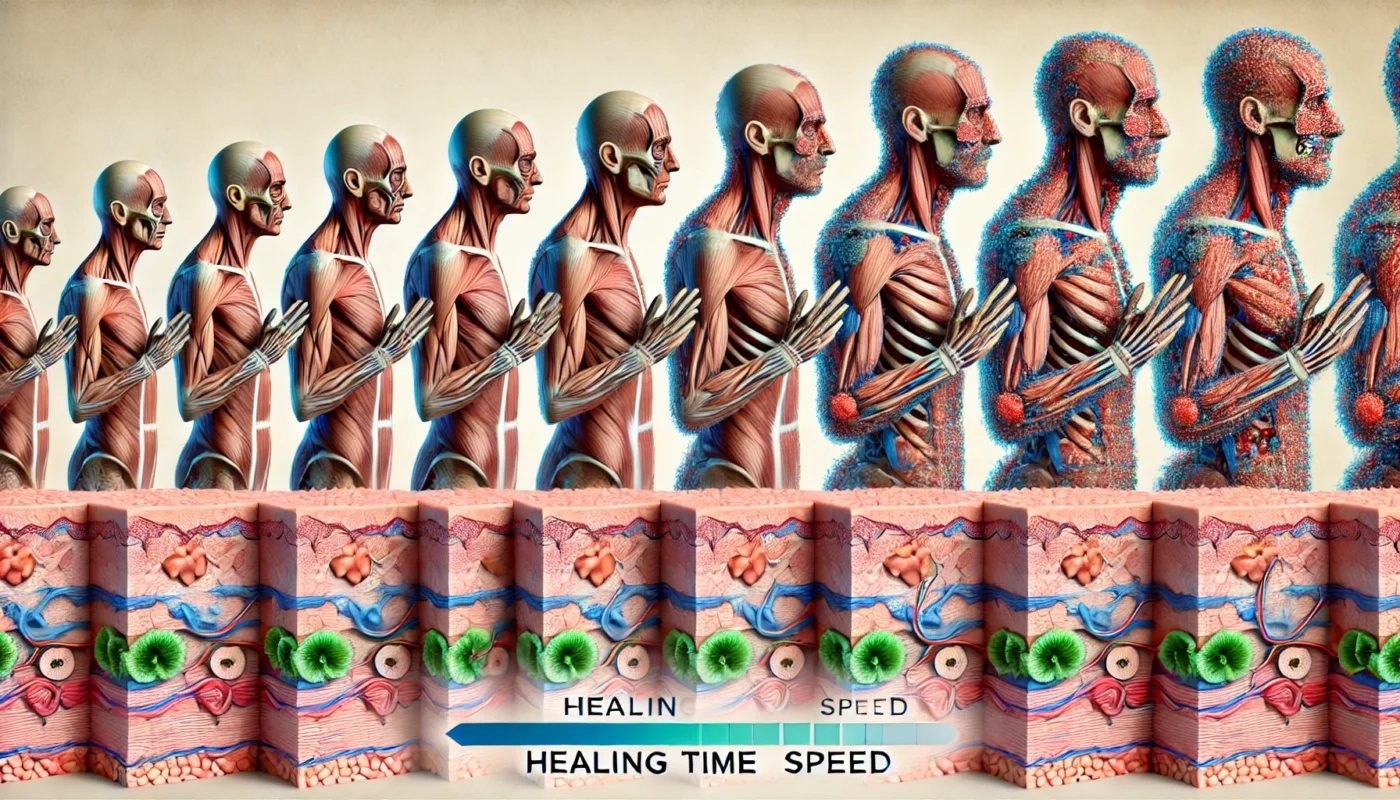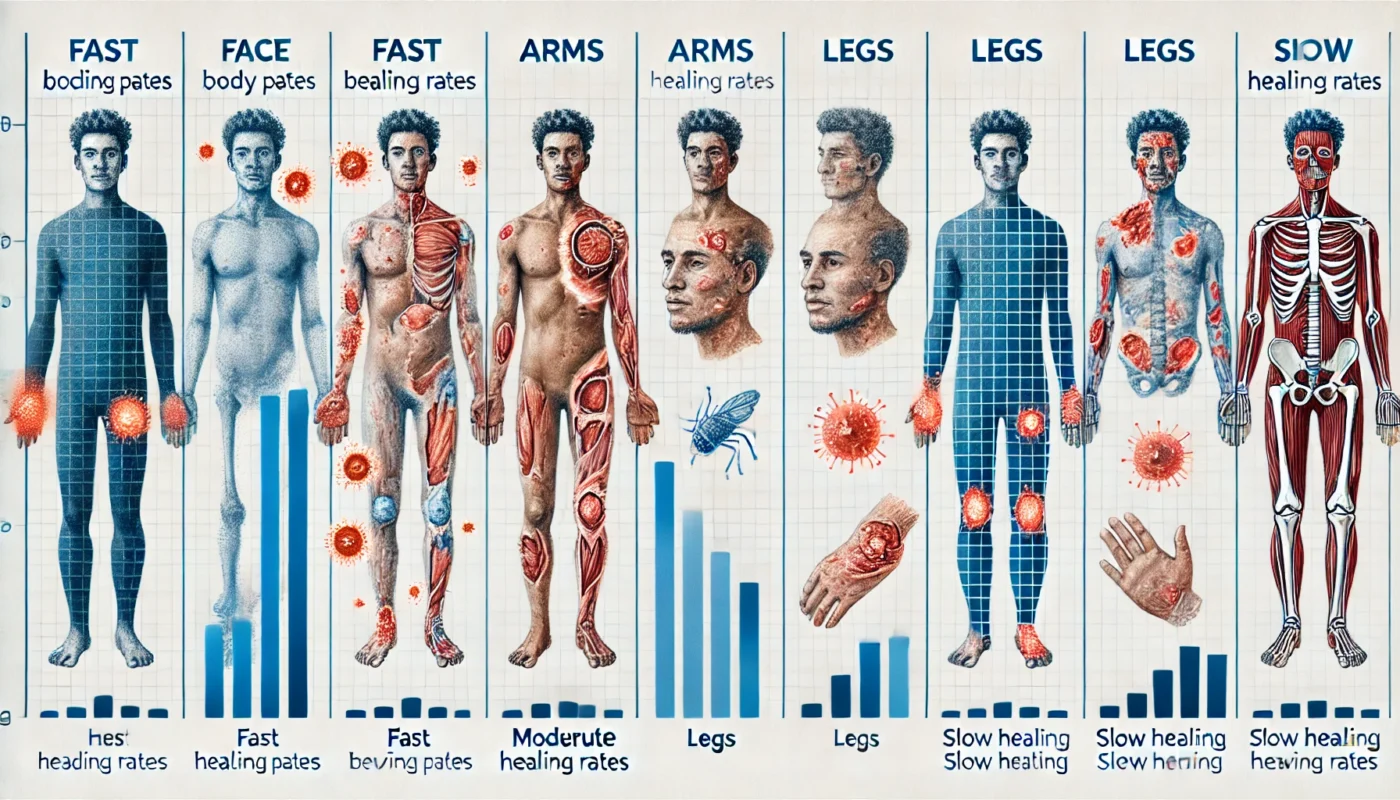Understanding the healing rates of different body parts can be crucial for fitness enthusiasts, health enthusiasts, and medical patients alike. Whether you’re recovering from an injury, managing a health condition, or simply curious about the human body’s capabilities, knowing which parts heal the fastest can guide your approach to recovery and wellness. This exploration delves into the scientific nuances and offers practical advice on optimizing healing.
You may also like: Key Factors in Proliferative Wound Healing
The Science Behind Healing
The body’s ability to heal is a complex process influenced by a variety of factors, including the type of tissue, blood supply, and the presence of specific cells involved in repair. Let’s break down the key components that determine how quickly a body part can heal.
Tissue Type
Different types of tissues have varying healing capacities. For instance, epithelial tissues, which form the skin and lining of organs, generally heal faster than connective tissues like tendons and ligaments. This is due to the higher cell turnover rate in epithelial tissues. Epithelial tissues are composed of tightly packed cells with a high regenerative ability, allowing for quick cell replacement. Connective tissues, on the other hand, are denser and have fewer cells, leading to slower repair processes.
Understanding the structural differences between tissues can help predict healing times. For example, muscle tissues, although part of the connective tissue family, have a better blood supply than tendons, which aids in faster recovery. Additionally, nerve tissues have a very slow healing process due to their complex structure and function.
Blood Supply
The availability of blood supply significantly impacts healing. Tissues with rich blood supply, such as muscles, heal more quickly because blood delivers essential nutrients and oxygen needed for repair. In contrast, areas with limited blood flow, like cartilage, heal slowly. The presence of capillaries in tissues not only delivers nutrients but also removes waste products, which is vital for efficient healing.
In areas with poor blood supply, such as ligaments and cartilage, healing can be prolonged and complicated. Improving circulation through gentle exercise and massage can potentially enhance healing rates in these areas. Additionally, medical interventions, such as angiogenesis-promoting therapies, may be considered to enhance blood flow and support healing.
Cellular Activity
The presence of specific cells, including fibroblasts, macrophages, and white blood cells, plays a crucial role in the healing process. These cells help in cleaning the wound, fighting infection, and laying down new tissue. Fibroblasts are essential for producing collagen, which provides strength and structure to the healing tissue.
Macrophages play a dual role by cleaning up debris and secreting factors that promote tissue repair. White blood cells, particularly lymphocytes, are involved in fighting infections that can complicate healing. The coordinated activity of these cells ensures that the healing process proceeds efficiently and effectively.
Genetic Factors
Genetic factors can also influence healing rates. Some individuals may have a genetic predisposition to faster or slower healing due to differences in cell proliferation and tissue regeneration capabilities. Genetic research is uncovering specific genes that affect healing, providing insights into personalized medicine approaches for enhancing recovery.
Understanding your genetic makeup can help tailor interventions to improve healing outcomes. Genetic testing may become a valuable tool in predicting healing rates and customizing treatment plans to optimize recovery.

Top 10 Fastest Healing Body Parts
With the scientific backdrop in place, let’s explore the body parts that are renowned for their rapid healing capabilities.
1. Tongue
The tongue is one of the fastest healing parts of the body. Its rich blood supply and constant exposure to saliva, which contains growth factors and enzymes, facilitate quick recovery from cuts and burns. The tongue’s muscular structure allows for efficient cell turnover and regeneration.
Saliva plays a crucial role by keeping the oral environment moist and promoting healing through its antimicrobial properties. The presence of unique proteins in saliva accelerates wound closure and reduces the risk of infection.
2. Mouth and Oral Mucosa
Similar to the tongue, the oral mucosa heals rapidly due to its vascular nature and the presence of saliva. This is why mouth ulcers and cuts generally resolve faster than skin wounds. The oral cavity’s environment promotes rapid epithelialization and tissue repair.
The constant mechanical stimulation from speaking and chewing may also enhance blood flow, contributing to quicker healing. Maintaining oral hygiene is essential to prevent infections that could delay recovery in this area.
3. Skin
The skin is a remarkable organ with robust healing abilities, especially when it comes to superficial wounds. The process of epithelialization, where new skin cells form and migrate to cover a wound, is efficient and quick in minor injuries. Skin has a layered structure that facilitates rapid repair and renewal.
Wound healing in the skin involves several stages, including inflammation, proliferation, and remodeling. Each stage is crucial for restoring the skin’s protective barrier and function. Topical treatments and dressings can support the healing process by maintaining a moist environment and protecting against infection.
4. Periosteum
The periosteum, a dense layer of vascular connective tissue enveloping the bones, heals relatively quickly due to its rich supply of blood vessels and nerves. This is crucial for bone healing after fractures. The periosteum’s cellular composition includes osteoblasts, which are essential for new bone formation.
Bone healing is a dynamic process that involves the coordinated activity of cells, growth factors, and mechanical forces. Immobilization and proper alignment of the fracture site are critical for successful healing. Nutritional support, including adequate calcium and vitamin D intake, can enhance bone repair.
5. Liver
The liver has an extraordinary ability to regenerate. Even after significant surgical removal or injury, the liver can regrow to its original size, thanks to its unique regenerative capacity. Hepatocytes, the liver’s main cell type, can rapidly proliferate and replace damaged tissue.
The liver’s regenerative ability is crucial for maintaining metabolic and detoxification functions. Supporting liver health through a balanced diet, avoiding excessive alcohol consumption, and managing underlying health conditions can optimize its regenerative potential.
6. Bladder
The bladder’s mucosal lining heals rapidly, which is beneficial in recovering from infections or after surgical interventions. Its regenerative ability is aided by a good blood supply and the presence of urothelial cells. The bladder’s capacity to expand and contract also supports the healing process.
Maintaining urinary tract health through hydration and hygiene practices can prevent infections that could interfere with healing. Medical treatments for bladder conditions may include medications and procedures that support tissue repair and function.
7. Fingernails and Toenails
Although not a soft tissue, nails are worth mentioning due to their relatively fast growth rate compared to other keratinized structures. Fingernails grow faster than toenails due to increased blood flow to the hands. The nail matrix, located under the cuticle, is responsible for producing new nail cells.
Nail growth can be influenced by factors such as age, nutrition, and overall health. Ensuring adequate intake of nutrients like biotin and maintaining nail hygiene can support healthy nail growth and repair.
8. Cornea
The cornea, the transparent front part of the eye, has a high regenerative capacity. Minor abrasions heal swiftly, aided by a rich supply of stem cells and a robust repair mechanism. The cornea’s avascular nature minimizes the risk of scarring during healing.
Protecting the eyes from injury and maintaining adequate lubrication can support corneal health. In cases of severe injury or disease, medical interventions such as corneal transplants may be necessary to restore vision and function.
9. Muscles
Muscles heal quickly after minor injuries due to a good blood supply and the presence of satellite cells that aid in repair and regeneration. However, recovery from severe muscle tears can be prolonged. Muscle healing involves inflammation, repair, and remodeling phases.
Rest, rehabilitation exercises, and nutritional support are essential for optimal muscle recovery. Managing inflammation through appropriate therapies can prevent complications and enhance healing outcomes.
10. Intestinal Epithelium
The intestinal lining undergoes constant renewal, with a complete turnover every few days. This rapid cell regeneration is vital for maintaining gut health and recovering from injuries or surgeries. The intestinal epithelium’s high cell turnover rate ensures efficient repair and function.
Supporting intestinal health through a balanced diet rich in fiber, probiotics, and prebiotics can enhance the gut’s regenerative capacity. Managing stress and avoiding irritants can also promote intestinal healing.

Factors Influencing Healing Rates
While some body parts are predisposed to heal quickly, various factors can influence these rates.
Nutrition
Proper nutrition provides the building blocks for tissue repair. Proteins, vitamins (especially A and C), and minerals like zinc play essential roles in the healing process. Ensuring a diet rich in these nutrients supports cellular functions and collagen synthesis.
Omega-3 fatty acids and antioxidants can reduce inflammation and promote healing. Consulting a nutritionist or healthcare provider can help tailor a diet to meet specific healing needs. Supplements may be considered when dietary intake is insufficient.
Age
Age is a significant determinant of healing capacity. Younger individuals generally heal faster due to higher metabolic rates and cell proliferation capabilities. As we age, cellular repair mechanisms slow down, and tissues may become less resilient.
Adopting healthy lifestyle practices, such as regular exercise and a balanced diet, can mitigate age-related declines in healing capacity. Interventions like physical therapy and regenerative medicine may also support healing in older adults.
Health Conditions
Chronic conditions like diabetes or compromised immune systems can impede the healing process. Managing underlying health issues is crucial for optimal recovery. Conditions such as peripheral vascular disease and autoimmune disorders can also affect healing rates.
Effective management of these conditions through medical treatment, lifestyle modifications, and monitoring can enhance healing outcomes. Collaborating with healthcare professionals is essential for addressing the complex interplay of factors affecting healing.
Lifestyle
A healthy lifestyle, including regular exercise and avoiding smoking and excessive alcohol consumption, can enhance the body’s natural healing processes. Exercise promotes circulation and tissue oxygenation, while smoking and alcohol can impair immune function and tissue repair.
Incorporating stress-reduction techniques, such as meditation and yoga, can further support healing by reducing the negative impact of stress hormones on the body. Lifestyle changes should be individualized to address specific health needs and goals.
Environmental Factors
Environmental factors, such as exposure to pollutants and allergens, can affect healing rates. Poor air quality and chemical irritants may exacerbate inflammation and delay recovery. Creating a clean, safe environment can minimize these risks and support healing.
Using protective measures, such as air purifiers and hypoallergenic products, can reduce environmental impacts on healing. Awareness of environmental triggers and proactive management can enhance overall health and recovery.

Practical Tips for Optimizing Healing
Based on the understanding of healing rates and influencing factors, here are some practical strategies to enhance recovery:
- Maintain a Balanced Diet: Incorporate foods rich in proteins, vitamins, and minerals to support tissue repair. Prioritize nutrient-dense foods like lean meats, fish, fruits, and vegetables to provide essential building blocks for healing.
- Stay Hydrated: Adequate hydration is essential for cellular functions and tissue regeneration. Water supports nutrient transport and waste removal, facilitating the healing process. Aim for at least 8 glasses of water per day, adjusting for activity level and climate.
- Rest and Recovery: Allow sufficient rest to enable the body to focus its energy on healing. Prioritize quality sleep and rest periods throughout the day to support recovery. Listen to your body’s signals and avoid overexertion that could impede healing.
- Exercise Appropriately: Engage in light exercises to promote blood circulation, but avoid overexertion that might hinder recovery. Tailor exercise routines to accommodate injury or health conditions, focusing on low-impact activities and stretching.
- Manage Stress: Stress can negatively impact the immune system, so practices like meditation and yoga can be beneficial. Incorporate relaxation techniques into daily routines to enhance mental and physical well-being. Seek professional support if stress becomes overwhelming.
- Seek Professional Guidance: Consult healthcare professionals for personalized advice and treatment plans. A multidisciplinary approach can address complex healing challenges and optimize outcomes. Regular follow-ups ensure progress and timely interventions.
- Utilize Supportive Therapies: Consider physical therapy, massage, and alternative therapies to aid recovery. These interventions can enhance circulation, reduce inflammation, and improve mobility. Ensure therapies are appropriate and guided by qualified practitioners.
Conclusion
Understanding the comparative healing rates of body parts equips you with the knowledge to manage recovery effectively. By recognizing which parts heal faster and the factors that influence healing, you can adopt strategies to enhance your body’s natural repair mechanisms. Remember, while the body has an incredible ability to heal, supporting it with proper nutrition, lifestyle choices, and care is essential for optimal health and wellbeing. Embrace a proactive approach to health, and leverage the body’s innate potential for healing and regeneration.
Further Reading:
Healing Expectations for Different Tissue Types
intestinal health, gut health, healing rates, nutrition, age, health conditions, lifestyle, environmental factors, recovery strategies, probiotics, prebiotics, stress management, hydration, exercise, tissue repair, wellness
Important Note: The information contained in this article is for general informational purposes only, and should not be construed as health or medical advice, nor is it intended to diagnose, prevent, treat, or cure any disease or health condition. Before embarking on any diet, fitness regimen, or program of nutritional supplementation, it is advisable to consult your healthcare professional in order to determine its safety and probable efficacy in terms of your individual state of health.
Regarding Nutritional Supplements Or Other Non-Prescription Health Products: If any nutritional supplements or other non-prescription health products are mentioned in the foregoing article, any claims or statements made about them have not been evaluated by the U.S. Food and Drug Administration, and such nutritional supplements or other health products are not intended to diagnose, treat, cure, or prevent any disease.

